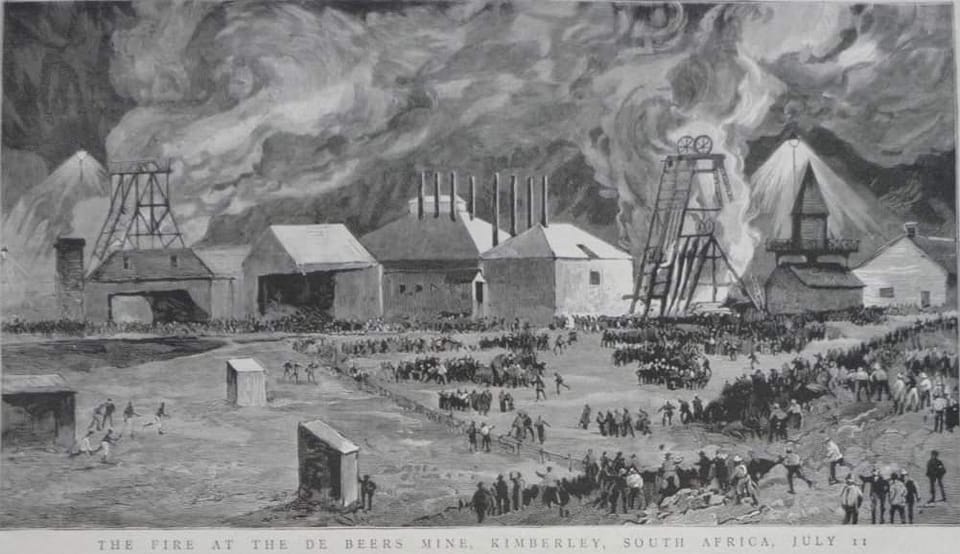Today in Kimberley's History
|
|
|
|
Underground fire at De Beers Mine kills 202 miners - 1888
11 July 1888 was the worst day in Kimberley’s history, with 202 miners being killed in the underground fire that nearly destroyed the De Beers Mine. This disaster is the world’s worst ever diamond mine disaster. "While the shifts were being changed the hauling wire broke and the skip rushed down the shaft with frightful rapidity. The oil lamps were broken, and the blazing fluid quickly ignited the wooden casing of the shaft. The mine was soon filled with smoke, and the lights carried by the miners were rendered useless. The panic-stricken natives and whites, in their efforts to escape, became massed together in the galleries and were suffocated to death. There were over 700 men below at the time. Two shafts have been destroyed. One remains intact. The works themselves are not much injured. The damage is estimated at £20,000. A great panic prevailed in Kimberley. The scenes described by the search parties were terrible. The miners had to use dynamite in order to clear the passages from the dead bodies."
11 July 1888 was the worst day in Kimberley’s history, with 202 miners being killed in the underground fire that nearly destroyed the De Beers Mine. This disaster is the world’s worst ever diamond mine disaster. "While the shifts were being changed the hauling wire broke and the skip rushed down the shaft with frightful rapidity. The oil lamps were broken, and the blazing fluid quickly ignited the wooden casing of the shaft. The mine was soon filled with smoke, and the lights carried by the miners were rendered useless. The panic-stricken natives and whites, in their efforts to escape, became massed together in the galleries and were suffocated to death. There were over 700 men below at the time. Two shafts have been destroyed. One remains intact. The works themselves are not much injured. The damage is estimated at £20,000. A great panic prevailed in Kimberley. The scenes described by the search parties were terrible. The miners had to use dynamite in order to clear the passages from the dead bodies."
Police arrest members of Umkhonto we Sizwe (MK) High Command at Lilliesleaf Farm - 1963
South African police raided the African National Congress (ANC) underground headquarters, the Liliesleaf Farm in Rivonia, just outside Johannesburg. Apparently it was decided that the 11th July 1963 would be the last time they would meet at the farm.Virtually the entire leadership of Umkhonto we Sizwe(MK), armed wing of the ANC, were arrested on this day. This moment came as a terrible titanic dream in the history of the ANC. Amongst those arrested were; Walter Sisulu, Govan Mbeki, Raymond Mhlaba, Ahmed Kathrada, Lionel Bernstein and Bob Hepple. Nelson Mandela, the commander-in-chief of MK, was not arrested at the time as he was serving a five-year prison sentence for leaving the country illegally in 1962. The farm was privately owned by Arthur Goldreich, but bought with funds from the Communist Party of South Africa (CPSA). At the farm police found documents relating to the manufacture of explosives, Mandela's diary of his African tour and copies of a draft memorandum, 'Operation Mayibuye'. It outlined a possible strategy of guerrilla war fare. The six men had been studying the document when police arrived. More arrests followed shortly after this incident, including Arthur Goldreich, Andrew Mlangeni, James Kantor, Dennis Goldberg, Harold Wolpe and Elias Motsoaledi. Goldreich and Wolpe later managed to escape from prison. Mandela and his co-accused were sentenced to life imprisonment in the Rivonia trial that ended in June 1964.
South African police raided the African National Congress (ANC) underground headquarters, the Liliesleaf Farm in Rivonia, just outside Johannesburg. Apparently it was decided that the 11th July 1963 would be the last time they would meet at the farm.Virtually the entire leadership of Umkhonto we Sizwe(MK), armed wing of the ANC, were arrested on this day. This moment came as a terrible titanic dream in the history of the ANC. Amongst those arrested were; Walter Sisulu, Govan Mbeki, Raymond Mhlaba, Ahmed Kathrada, Lionel Bernstein and Bob Hepple. Nelson Mandela, the commander-in-chief of MK, was not arrested at the time as he was serving a five-year prison sentence for leaving the country illegally in 1962. The farm was privately owned by Arthur Goldreich, but bought with funds from the Communist Party of South Africa (CPSA). At the farm police found documents relating to the manufacture of explosives, Mandela's diary of his African tour and copies of a draft memorandum, 'Operation Mayibuye'. It outlined a possible strategy of guerrilla war fare. The six men had been studying the document when police arrived. More arrests followed shortly after this incident, including Arthur Goldreich, Andrew Mlangeni, James Kantor, Dennis Goldberg, Harold Wolpe and Elias Motsoaledi. Goldreich and Wolpe later managed to escape from prison. Mandela and his co-accused were sentenced to life imprisonment in the Rivonia trial that ended in June 1964.


